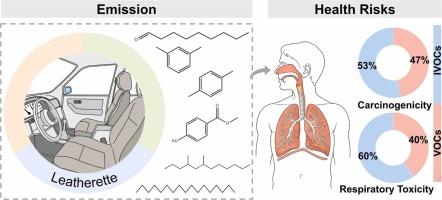车辆舱室中未被识别的中间挥发性有机化合物排放和健康风险:来自非目标分析方法的见解
IF 11.3
1区 环境科学与生态学
Q1 ENGINEERING, ENVIRONMENTAL
引用次数: 0
摘要
随着汽车保有量的增加和通勤时间的延长,车内空气质量已成为日益关注的公共卫生问题。然而,缺乏有机化合物在整个挥发性范围内的综合表征限制了我们对其化学复杂性和健康影响的理解,特别是对中等挥发性有机化合物(IVOCs)。在这里,我们采用全面的二维气相色谱-飞行时间质谱(GC×GC-TOF-MS)对使用中的乘用车中的污染物进行非靶向分析,其中包括三种内部装饰,即真皮,人造革和纺织品。共鉴定出176种气态有机物。真皮(592.7±229.1 μg m-3)和真皮内饰(629.5±137.9 μg m-3)车辆的总有机浓度比纺织内饰(246.1±22.9 μg m-3)高出约2.5倍。烷烃占所有测试车辆的32-58%,其次是含氧成分(25-34%)。值得注意的是,IVOCs不仅占舱内污染物的52-60%,而且具有相当大的健康问题,占呼吸毒性的55-62%,占致癌性的45-56%。这些发现强调了IVOCs在车内微环境中被忽视的作用,并为未来的车内空气质量法规和健康风险缓解策略提供了重要见解。本文章由计算机程序翻译,如有差异,请以英文原文为准。

Unrecognized Emissions and Health Risks of Intermediate-Volatility Organic Compounds in Vehicle Cabins: Insights from a Nontargeted Analytical Approach
With increasing vehicle ownership and commuting time, vehicle in-cabin air quality has emerged as a growing public health concern. However, the lack of comprehensive characterization of organic compounds across the full volatility range has limited our understanding of their chemical complexity and health impacts, particularly for intermediate-volatility organic compounds (IVOCs). Here, we employed comprehensive two-dimensional gas chromatography-time-of-flight mass spectrometry (GC×GC-TOF-MS) for non-targeted analysis of pollutants in in-use passenger cars, featuring three types of interior upholstery, i.e., real leather, leatherette, and textile. A total of 176 gaseous organic species were identified. Vehicles with real leather (592.7 ± 229.1 μg m–3) and leatherette interiors (629.5 ± 137.9 μg m–3) exhibited total organic concentrations roughly 2.5-fold higher than those with textile upholstery (246.1 ± 22.9 μg m–3). Alkanes accounted for 32–58% for all tested vehicles, followed by oxygenated components (25–34%). Notably, IVOCs not only accounted for 52–60% of in-cabin pollutants, but also posed considerable health concerns, contributing 55–62% to respiratory toxicity and 45–56% to carcinogenicity. These findings underscore the overlooked role of IVOCs in vehicular microenvironment and provide crucial insights for future in-cabin air quality regulations and health risk mitigation strategies.
求助全文
通过发布文献求助,成功后即可免费获取论文全文。
去求助
来源期刊

Journal of Hazardous Materials
工程技术-工程:环境
CiteScore
25.40
自引率
5.90%
发文量
3059
审稿时长
58 days
期刊介绍:
The Journal of Hazardous Materials serves as a global platform for promoting cutting-edge research in the field of Environmental Science and Engineering. Our publication features a wide range of articles, including full-length research papers, review articles, and perspectives, with the aim of enhancing our understanding of the dangers and risks associated with various materials concerning public health and the environment. It is important to note that the term "environmental contaminants" refers specifically to substances that pose hazardous effects through contamination, while excluding those that do not have such impacts on the environment or human health. Moreover, we emphasize the distinction between wastes and hazardous materials in order to provide further clarity on the scope of the journal. We have a keen interest in exploring specific compounds and microbial agents that have adverse effects on the environment.
 求助内容:
求助内容: 应助结果提醒方式:
应助结果提醒方式:


